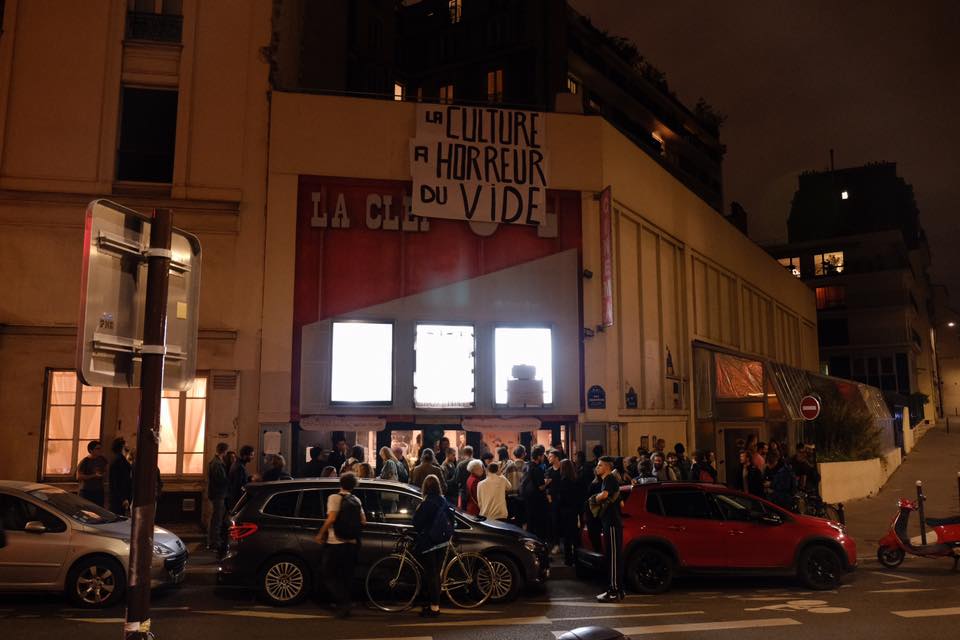The La Clef cinema between self-organization and institutionalization in the Parisian cultural milieu
DOI:
https://doi.org/10.13133/2532-6562/18166Keywords:
associative cinema, militantism, institutionalisationAbstract
The Parisian cinema La Clef was occupied to avoid its closure in September 2019. Since then, it has been portrayed as the last associative cinema in the city. This text traces its genesis and the specific practices of occupation. In particular, we will focus on the event of the eviction, which occurred during our field research period, observing the evolution of the rhetoric and practices used, from militant to entrepreneurial, from an independent posture to a search for legitimacy and recognition. The acquisition project of the historical site marks the transition from the sphere of informality to the institutional one and reveals the link between the valorisation of urban spaces, participatory and alternative art and institutions. The text explores this relationship starting with the case study of the Clef, but relates it more generally to other art experiences of the city of Paris.
References
Aguilera T. (2012). «Gouverner les illégalismes urbains. Les politiques urbaines face aux squats à Paris». Gouvernement et action publique, 1: 111-124. DOI: 10.3917/gap.123.0101.
Aguilera T. (2010). «Réguler et policer les squats à Paris. Politiques publiques et construction de l’ordre». Metropoles, 24. DOI: https://doi.org/10.4000/metropoles.6865.
Castells M. (1973). La question urbaine. Paris: François Maspero.
Collectif Prenons la ville (2020). «Une gestion urbaine à la cool». L’en-ville 3. Récits de transformations urbaines sur Montreuil et Bagnolet, 3: 19-21. Testo disponibile al sito: https://infokiosques.net/spip.php?article1778. 3/6/2022.
Collettivo Mauvaise Troupe (2017). Contrade. Storie di Zad e Notav. Valsusa: Tabor.
Correia M. (2018). «L’envers des friches culturelles». Revue du crieur, 11: 52-57. DOI: 10.3917/crieu.011.0052.
Debord G. (1967). La société du spectacle. Paris: Éditions Buchet-Chastel (trad. It. 1979, La società dello spettacolo. Firenze: Vallecchi).
Dechezelles S., Olive M. (2017). «Les mouvements d’occupation: agir, protester, critiquer». Politix, 117: 7-34. DOI: 10.3917/pox.117.0007.
Dell’Umbria A. (2018). «Zad, pour l'autodéfense et la communalité». Lundimatin. Testo disponibile al sito: https://lundi.am/ZAD-pour-l-autodefense-et-la-communalite-par-Alessi-Dell-Umbria. 18/10/2022.
Delaleu A. (2017). «Urbanisme Transitoire: dernier intermède avant gentrification». Chroniques d’architecture. Testo disponibile al sito: https://chroniques-architecture.com/urbanisme-transitoire-gentrification/. 18/10/2022.
Faburel G. (2018). Les métropoles barbares: démondialiser la ville, désurbaniser la terre. Paris: Le Passager Clandestin.
Laplantine F. (2018). Penser le sensible. Paris: Pocket.
Langeard C. (2007). «Les émotions comme ferment de l’identité collective». Terrains & travaux, 13: 13-30. DOI: https://doi.org/10.3917/tt.013.0013.
Montoya N. (2008). «Construction et circulation d’ethos politiques dans les dispositifs de médiation culturelle». Terrains et travaux, 13: 119-135. DOI: 10.3917/tt.013.0013.
Niessen B. (2009). Going commercial. L’integrazione degli artisti underground a Milano e Berlino. Tesi di dottorato, Dottorato di Urban and local European Studies, Università degli Studi di Milano-Bicocca.
Osservatorio repressione e riqualificazione (2022). «Imprese sociali e riqualificazione a Catania». Lo stato delle città, 9: 59-64. Napoli: Monitor edizioni.
Prieur V. (2015). «Revendications des squats d’artistes et institutions». Marges, 21: 73-95. DOI: https://doi.org/10.4000/marges.1035.
Pruijt H. (2003). «Is the institutionalization of urban movements inevitable? A comparison of the opportunities for sustained squatting in New York City and Amsterdam». International Journal of Urban and Regional Research, 27:133-157. DOI: 10.1111/1468-2427.00436.
Tozzi L. (2021). «Il circo dell’innovazione. Miti e retoriche dell’offerta culturale a Milano». Lo stato delle città, 6: 68-71. Napoli: Monitor Edizioni.
Vermylen A. (2019). «Par-delà les émotions et la raison. Les apports de l’auto-analyse comme méthode de compréhension de nos terrains». e-Migrinter, 18. DOI: 10.4000/e-migrinter.1781.
Vermylen A., Manaï B., Desille A. (2019). «Post-colonialisme, hyper-sécurisation des frontières et ethnographie». e-Migrinter, 18. DOI: 10.4000/e-migrinter.1628.
Vivant E. (2006). Le rôle des pratiques culturelles off dans les dynamiques urbaines. Tesi di dottorato, Dottorato di Geografia, Université Paris VIII Vincennes-Saint Denis.
Vivant E. (2007). «Sécurisation, pacification, animation. L’instrumentalisation des scènes culturelles off dans les politiques urbaines». Terrains et travaux, 13: 169-188, DOI: 10.3917/tt.013.0169.
Vivant E., Dumont M. (2016). «Du squat au marché public. Trajectoire de professionnalisation des opérateurs de lieux artistiques off». La Découverte, 200: 181-208, DOI:10.3917/res.200.0181.

Downloads
Published
How to Cite
Issue
Section
License
Copyright (c) 2023 Barbara Russo, Marguerite Foucher

This work is licensed under a Creative Commons Attribution 4.0 International License.
NOTA DI COPYRIGHT
Proposta di licenza Creative Commons
1. Proposta per riviste Open Access
Gli autori che pubblicano su questa rivista accettano le seguenti condizioni:
Gli autori mantengono i diritti sulla loro opera e cedono alla rivista il diritto di prima pubblicazione dell'opera, contemporaneamente licenziata sotto una Licenza Creative Commons - Attribuzione che permette ad altri di condividere l'opera indicando la paternità intellettuale e la prima pubblicazione su questa rivista.
Gli autori possono aderire ad altri accordi di licenza non esclusiva per la distribuzione della versione dell'opera pubblicata (es. depositarla in un archivio istituzionale o pubblicarla in una monografia), a patto di indicare che la prima pubblicazione è avvenuta su questa rivista.
Gli autori possono diffondere la loro opera online (es. in repository istituzionali o nel loro sito web) prima e durante il processo di submission, poiché può portare a scambi produttivi e aumentare le citazioni dell'opera pubblicata (Vedi The Effect of Open Access).

